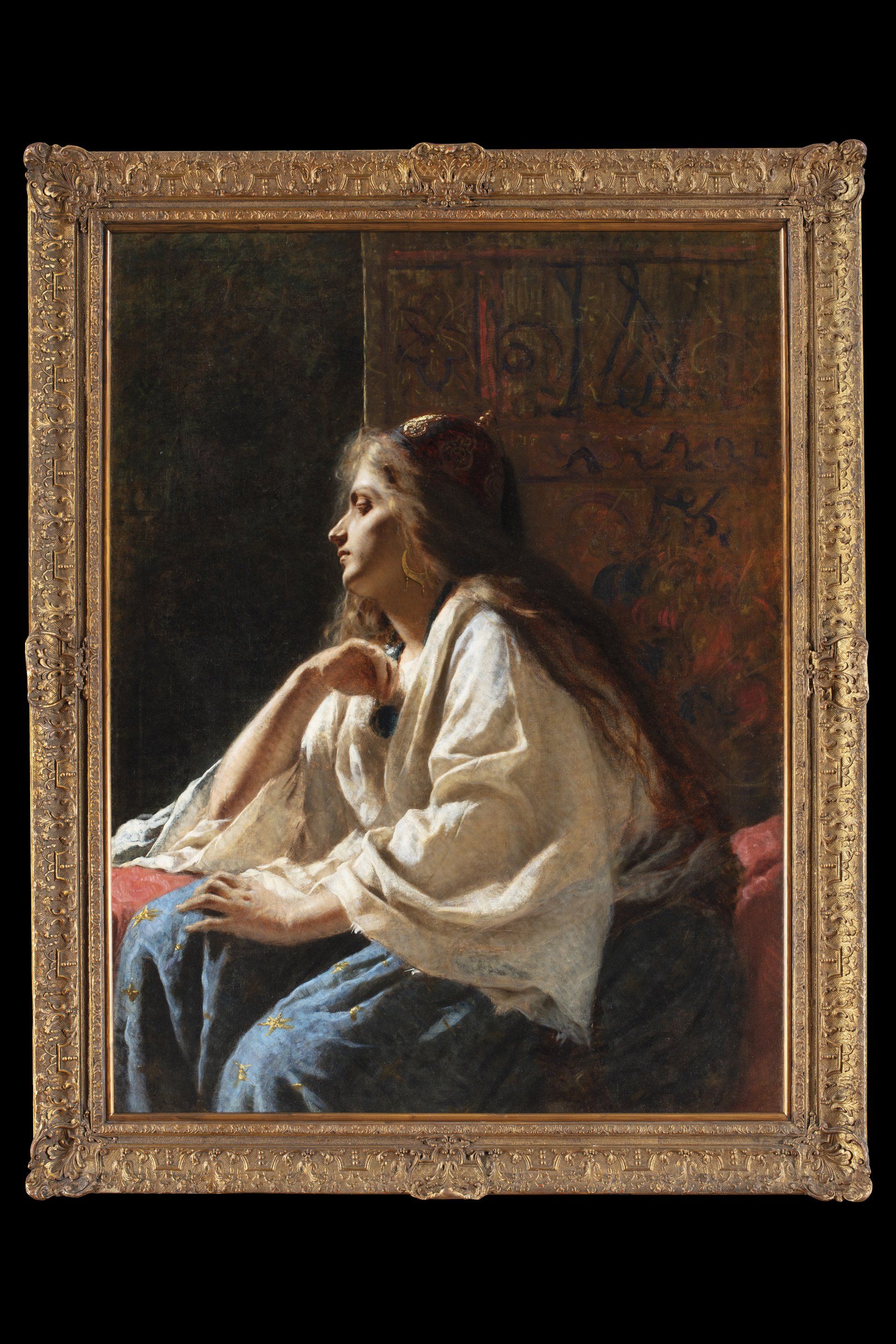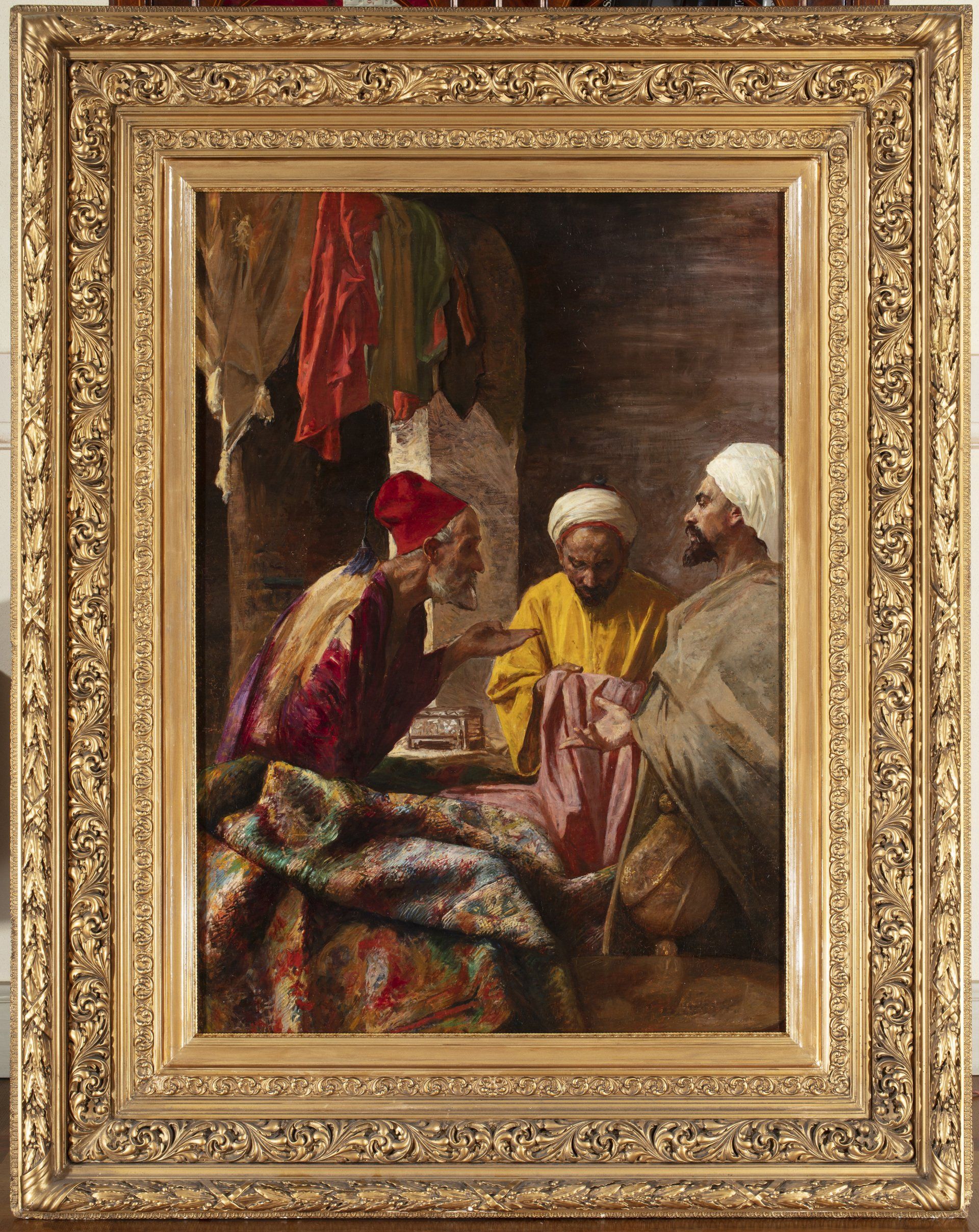Orientalist painting Western girl dressed as an odalisque
Period: 19th century
Oil painting on canvas depicting a western girl dressed as Odalisque in oriental clothing absorbed at the window inside a Harem. Italian school of the second half of the 19th century. Measures 131x97.5 cm. The princesses along with the odalisques and slaves from every region of the vast Turkish empire (Greek, Georgian, Circassian) spent their time between lunches, pipe smoking, coffee, tea and long conversations. Only towards evening did they go down to the garden, preceded by the eunuchs who made any visitors withdraw. Sometimes some drama darkened the monotony of everyday life: it happened that the master fell in love with a slave who gave him a child and that the mistress, seized by violent jealousy, would reunite the poor girl in a cell. However, it is erroneous to suppose that Turkish women were unhappy, since, in addition to the supreme happiness of raising offspring and becoming loving mothers, there was no shortage of pastimes such as dancing, singing, bathing, walking, dressing and even idleness. which was regarded as one of the pleasures of life.
ORIENTALISM
Orientalism indicates a tendency, a taste in art that wants to represent and resume aspects of Middle Eastern and Asian culture. It is not a real movement because it does not characterize a particular style, but rather a choice of themes, iconography. Artists belonging to different currents, such as Impressionists, Romantics and others, have produced works attributable to this particular current.
This phenomenon is characterized by a general interest in oriental themes and by admiration for the civilizations of the Mediterranean, the Arabian Peninsula and Central-Southern Asia. The interest arose initially with the rediscovery of these places during the Napoleonic expedition of 1798 in Egypt, in which they are also involved several experts including designers, archaeologists, explorers and scientists, who documented aspects of local culture that then make known in Europe. The fascination of this world so mysterious and distant for Europeans grows in the second half of the nineteenth century, fueled, for example, by Champollion's decipherment of hieroglyphics and descriptions of explorers who travel in the mythical East.
The country in which the fortune of Orientalism began is France; it then interested other European countries as well.
The most popular subjects are, for example, the colorful bazaars, the alleys and squares of cities teeming with vendors, the desert with the caravans and camels, the ruins of ancient monuments, mosques and rituals of Islam. The figure of the woman is predominant in this type of painting: she is often depicted inside the harem, the oriental gynaeceum that has always fascinated Westerners. Here we find mysterious female figures, often in sensual or provocative poses. They are often found engaged in body care or while dancing, or in a moment of rest. One finds the so-called odalisques, concubines or slaves who stay with their wives.
The environments of the harem and, together with this, of the hammam, the Turkish bath, are represented rich in architectural decorations and with furnishings covered with precious fabrics.
Among the artists who dedicated themselves to oriental themes there are many who had never visited the Orient: they took inspiration from the drawings of travelers and from their own imagination. Some, on the other hand, undertook long journeys and tried to give a more similar aspect to the truth of the reality portrayed in their paintings.
COLLECTING
While in the eighteenth century you look at the Far East and want furniture and porcelain inspired by Chinese art, in the nineteenth century becomes the trend of the Near East Mediterranean and areas of Persia and Arabia. The European aristocracies had always been interested in places considered exotic, different from their own. After Napoleon's campaign in Egypt and the study of ancient Egyptian civilization, Egyptomania broke out and interested in everything that came from Egypt. Even the Ottoman Empire had a certain charm, so much so that many Europeans were portrayed wearing Turkish inspired clothes.
The charm of these distant lands, rich and exotic, is often imagined as it is handed down by the Thousand and One Nights, a collection of oriental tales that became very popular. The Orientalist paintings that are produced during this season reproduce in detail these places and are in many cases of high historical interest. They are works of great quality that even today are highly appreciated and are increasingly sought after internationally.
Contact us for information regarding the work on display
Fill out the form or call to arrange a meeting
Mobile +39 335 8125486
Mobile +39 335 7774612
Thanks for contacting us. We will get back to you as soon as possible.
An error occurred while sending the message. Please try again later

Opening time
- Monday
- - -
- Tue, Wed, Fri
- - -
- Thursday
- -
- Saturday
- - -
- Sunday
- Closed
Via Roma, 22 / a, 42100 Reggio Emilia RE
contact info
Ph. +39 0522 704575
Mobile +39 335 8125486
Mobile +39 335 7774612
Sign up to our newsletter
and stay informed
Subscribe to the newsletter
Thanks for contacting us. We will get back to you as soon as possible
An error occurred while sending the message. Please try again later
Phidias Antiques VAT number 00655091205 - Copyrights © 2022 Privacy policy Company Register of Bologna n. 48267 - Int. vers. euro 10,400 - Type of company: srl








